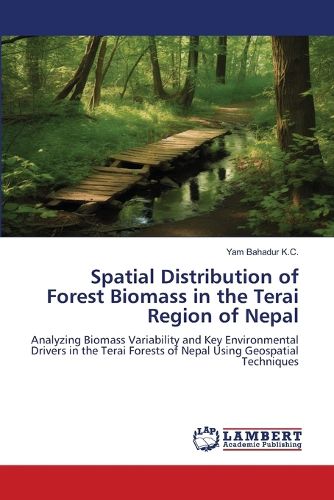Readings Newsletter
Become a Readings Member to make your shopping experience even easier.
Sign in or sign up for free!
You’re not far away from qualifying for FREE standard shipping within Australia
You’ve qualified for FREE standard shipping within Australia
The cart is loading…






Forests play a vital role in global carbon cycles, necessitating accurate above-ground biomass (AGB) estimation for climate strategies. This study focuses on Nepal's Central Terai, integrating airborne LiDAR, field inventory, and multisource satellite imagery (PlanetScope, Sentinel-2) for AGB estimation. LiDAR data (32 metrics) and field measurements (110 plots) were used, with Random Forest (RF) outperforming stepwise linear regression (R (2) = 0.85, RMSE = 60.9 ton/ha). Further integration with Sentinel-2 improved accuracy (R (2) = 0.92, RMSE = 44.58 ton/ha). AGB distribution was influenced by climate, topography, and human activity, with land use, temperature, and precipitation explaining 64% of variability. Higher AGB was linked to moderate climate conditions, elevation, and river proximity, while roads negatively impacted biomass. The study highlights LiDAR's utility, machine learning's role in enhancing AGB estimation, and the need for integrated remote sensing approaches for sustainable forest management and climate adaptation in biodiversity-rich regions.
$9.00 standard shipping within Australia
FREE standard shipping within Australia for orders over $100.00
Express & International shipping calculated at checkout
Stock availability can be subject to change without notice. We recommend calling the shop or contacting our online team to check availability of low stock items. Please see our Shopping Online page for more details.
Forests play a vital role in global carbon cycles, necessitating accurate above-ground biomass (AGB) estimation for climate strategies. This study focuses on Nepal's Central Terai, integrating airborne LiDAR, field inventory, and multisource satellite imagery (PlanetScope, Sentinel-2) for AGB estimation. LiDAR data (32 metrics) and field measurements (110 plots) were used, with Random Forest (RF) outperforming stepwise linear regression (R (2) = 0.85, RMSE = 60.9 ton/ha). Further integration with Sentinel-2 improved accuracy (R (2) = 0.92, RMSE = 44.58 ton/ha). AGB distribution was influenced by climate, topography, and human activity, with land use, temperature, and precipitation explaining 64% of variability. Higher AGB was linked to moderate climate conditions, elevation, and river proximity, while roads negatively impacted biomass. The study highlights LiDAR's utility, machine learning's role in enhancing AGB estimation, and the need for integrated remote sensing approaches for sustainable forest management and climate adaptation in biodiversity-rich regions.